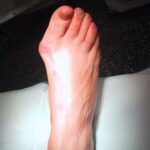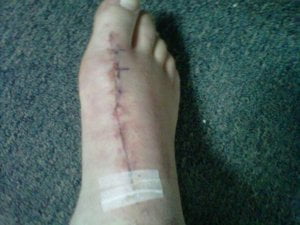You may want to check with your health care provider and see what the cost of removing a bunion is. You may not even know what a bunion is, do you?
Most people give very little consideration to the care of their feet over the years. As they become older even the smallest of bumps can develop into serious health and mobility issues. Where possible, ask your parents if they or your grandparents have bunions or other foot problems. Now check your health care plan to see if it will cover the cost of seeing a podiatrist. Tell them of your family history and have them teach you how to take care of your feet now, to reduce the likelihood of more frequent visits later. Your health care plan will not cover pre-existing conditions in almost all cases, so the expense will be astronomical if you leave this until it becomes an emergency because you can’t walk.
What Are Bunions?
Bunions occur in the large joint where the big toe meets the foot. As they grow larger they cause the big toe to turn inward toward the other toes. The bump on the joint grows larger over time, producing a bony growth which can become quite painful. Wearing ill fitting shoes can cause bunions to become far worse in a shorter time. This is especially true if you continually tip-toe around in high heels or shoes which are too tight and constricting. Incorrect shoes will not cause bunions though, as the foot structure, posture and the way you walk is inherited. Do you have flat feet? If so, you are at a higher risk of developing bunions.
Treatment:
Wearing more loose fitting shoes and inserting padding into the shoes may well solve the problem of mobility and reduce pain significantly. A physical therapist can prescribe orthotic shoes, or cortisone injections may become necessary if your bunions are giving you more pain than you can tolerate. There are other treatments, and what route you take will of course depend on how serious the problem has become for you. Sometimes a simple anti-inflammatory drug can be prescribed to help reduce swelling and sensitivity. As a last resort, a Bunionectomy, or Hallux valgus correction, can be performed. This is only done where absolutely necessary as it the more invasive solution. Sometimes this surgery is a must have though, if your foot becomes deformed from having the bunion, or if mobility is hindered substantially. An incision is made along the area where the bunion is present, and the deformity is repaired and excess bone growth is removed. Recovery is around 4 – 6 weeks and is generally 100% successful. Occasionally a recurring deformity can happen and further surgery may be required.
Your Children’s Foot Care:
Buying new shoes is always fun. Remember as a child you were bought new shoes and just had to leave the store wearing them? As it is impossible to avoid any inherited foot problems, care should be taken not to promote any condition which may be likely to occur later. It is extremely important to learn how to care for your feet at a young age. Therefore, you should teach your children the importance of wearing shoes which are stylish as well as comfortable. Since the latest fashion trends will sometimes see them wearing shoes which may cause damage, correct sizing by a professional is very important. Even sloppy, loose fitting shoes can cause damage because your child will not walk correctly. When possible, purchase shoes from a store where your foot can be properly measured, rather than guessing your size and purchasing the fanciest pair you find directly off the rack. If your teen understands the consequences of doing this, they will learn how to properly care for their feet now and be very thankful you taught them this valuable lesson.
Source:
American College Of Foot And Ankle Surgeons.
http://www.footphysicians.com/footankleinfo/bunions.htm



